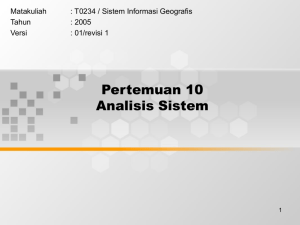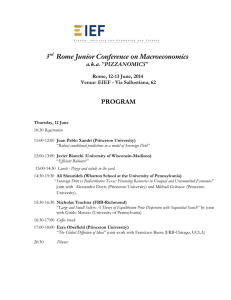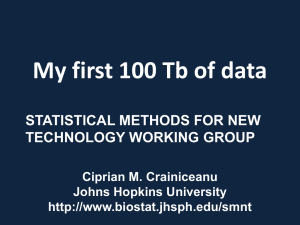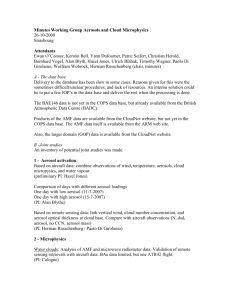Document 13759951
advertisement
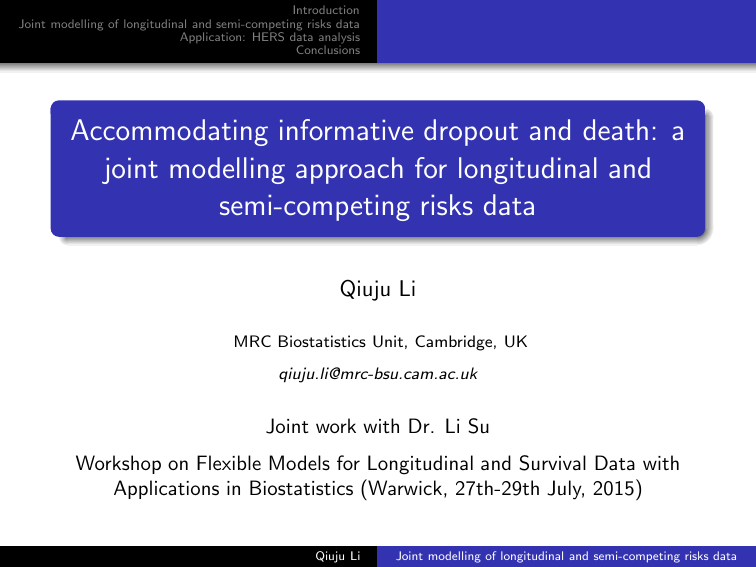
Introduction
Joint modelling of longitudinal and semi-competing risks data
Application: HERS data analysis
Conclusions
Accommodating informative dropout and death: a
joint modelling approach for longitudinal and
semi-competing risks data
Qiuju Li
MRC Biostatistics Unit, Cambridge, UK
qiuju.li@mrc-bsu.cam.ac.uk
Joint work with Dr. Li Su
Workshop on Flexible Models for Longitudinal and Survival Data with
Applications in Biostatistics (Warwick, 27th-29th July, 2015)
Qiuju Li
Joint modelling of longitudinal and semi-competing risks data
Introduction
Joint modelling of longitudinal and semi-competing risks data
Application: HERS data analysis
Conclusions
Outline
1
Introduction
2
Joint modelling of longitudinal and semi-competing risks data
3
Application: HERS data analysis
4
Conclusions
Qiuju Li
Joint modelling of longitudinal and semi-competing risks data
Introduction
Joint modelling of longitudinal and semi-competing risks data
Application: HERS data analysis
Conclusions
Introduction
longitudinal and semi-competing risks data, e.g., CD4 counts, dropout and
HIV-related death in the HIV epidemiology research study (HERS).
3
4
5
6
7
8
9
10
11
25
20
15
10
12
0
1
2
3
4
5
6
7
visit (subject=100058)
visit (subject=101059)
death
dropout & death
8
9
10
11
12
0
1
2
3
4
5
6
7
8
9
10
11
8
9
10
11
12
25
20
15
10
5
squart root of CD4 counts
12
visit (subject=100729)
0
25
5
10
15
20
Measurements
dropout
death
0
squart root of CD4 counts
5
squart root of CD4 counts
2
30
1
30
0
0
25
20
15
10
5
0
squart root of CD4 counts
30
dropout
30
complete data
0
1
2
3
4
5
6
7
visit (subject=100241)
Qiuju Li
Joint modelling of longitudinal and semi-competing risks data
Introduction
Joint modelling of longitudinal and semi-competing risks data
Application: HERS data analysis
Conclusions
Some concepts
mortal cohort;
immortal cohort;
(Aalen and Gunnes, 2010)
longitudinal profile models:
unconditional models, e.g., random-effects models f (Yi (t));
fully conditional models, e.g., f (Yi (t)|Si = s), s > t;
partly conditional models, e,g., f (Yi (t)|Si > t) (Kurland and
Heagerty, 2005; Kurland et al., 2009);
GEE approaches;
a likelihood-based joint modelling approach proposed
subsequently.
Qiuju Li
Joint modelling of longitudinal and semi-competing risks data
Introduction
Joint modelling of longitudinal and semi-competing risks data
Application: HERS data analysis
Conclusions
Notation
scheduled repeated measurements of a longitudinal outcome
Yi = (Yi 1 , . . . , YiM )′ , taken at visits 1, . . . , M, e.g., M = 12
for the HERS data;
informative dropout and death
dropout time denoted by Di , observed data
Di∗ = min(Di , Si , Ci ), δiD = I (Di ≤ Si , Di ≤ Ci );
death time denoted by Si , observed data Si∗ = min(Si , Ci ),
δiS = I (Si ≤ Ci );
Ci denotes non-informative censoring, e.g., end of study;
covariates Xi , e.g., sex, treatment arm;
Qiuju Li
Joint modelling of longitudinal and semi-competing risks data
Introduction
Joint modelling of longitudinal and semi-competing risks data
Application: HERS data analysis
Conclusions
Time-to-event processes
Time-to-event data,
time to dropout: last visit of follow-up;
time to death:
Ti
time to death:
τ
0
τ : the end of study.
Qiuju Li
Joint modelling of longitudinal and semi-competing risks data
Introduction
Joint modelling of longitudinal and semi-competing risks data
Application: HERS data analysis
Conclusions
Time-to-event processes
Discrete time-to-event data (mathematical attractiveness),
time to dropout: last visit of follow-up;
time to death:
Ti
time to death:
0
t1
tr −1
tr
t(M−1)
τ
τ : the end of study.
the discrete death time Si = r (Barrett et al, 2015, JRSSB).
Qiuju Li
Joint modelling of longitudinal and semi-competing risks data
Introduction
Joint modelling of longitudinal and semi-competing risks data
Application: HERS data analysis
Conclusions
Joint models
Joint models for the longitudinal and semi-competing risks data,
T
T
Yij = xij β + zij bi + ǫij
T
T
Pr (Di = r |Di ≥ r ) = 1 − Φ(xD,ir
αD + γD,r
WD,ir bi ) ,
T
T
Pr (Si = r |Si ≥ r ) = 1 − Φ(xS,ir αS + γS,r WS,ir bi )
Φ(·) standard normal cdf;
β, αD , αS regression coefficients; γD,r , γS,r association effects;
random effects bi ∼ N(0, Σb );
iid
ǫij ∼ N(0, σ 2 );
WD,ir bi , WS,ir bi vectors of linear combinations of random effects,
e.g., WD,ir bi = (bi 0 , bi 1 )T ;
conditional independence assumption given random effects bi ;
Qiuju Li
Joint modelling of longitudinal and semi-competing risks data
Introduction
Joint modelling of longitudinal and semi-competing risks data
Application: HERS data analysis
Conclusions
Likelihood function,
Y
Li (θ; yi , Di∗ , δiD , Si∗ , δiS )
i
=
YZ
i
∞
f (longitudinal data|θ, bi )×
−∞
Pr (dropout data|θ, bi ) × Pr (death data|θ, bi ) × f (bi |θ)dbi .
Qiuju Li
Joint modelling of longitudinal and semi-competing risks data
Introduction
Joint modelling of longitudinal and semi-competing risks data
Application: HERS data analysis
Conclusions
Semi-competing risks data
Four possible scenarios of the observed time-to-event data,
(1) neither dropout nor death:
Di∗ = d, Si∗ = s, (δiD , δiS ) = (0, 0);
(2) dropout only:
Di∗ = d, Si∗ = s, (δiD , δiS ) = (1, 0);
(3) death only:
Di∗ = d, Si∗ = s, (δiD , δiS ) = (0, 1);
(4) both dropout and death:
Di∗ = d, Si∗ = s, (δiD , δiS ) = (1, 1);
Qiuju Li
Joint modelling of longitudinal and semi-competing risks data
Introduction
Joint modelling of longitudinal and semi-competing risks data
Application: HERS data analysis
Conclusions
For the scenario (1), the likelihood function of observed data
{yi = (yi 1 , . . . , yini )′ , Di∗ = d, δiD = 0, Si∗ = s, δiS = 0},
Li (θ; yi , Di∗ , δiD , Si∗ , δiS )
Z ∞
d
Y
T
T
=
φ(yi ; xi β + zi bi , σ 2 Ini )
Φ(xD,ir
αD + γD,r
WD,ir bi )
−∞
s
Y
k=1
T
T
Φ(xS,ir
αS + γS,r
WS,ir bi )φ(bi ; 0, Σb )dbi
ℓ=1
T
)
=Li 1 (·\bi )Φ(d+s) (Ads + Bds hi ; 0, Id+s + Bds Hi−1 Bds
closed-form likelihood (skewed normal distribution, Arnold 2009);
Li 1 (·\bi ), hi , Hi , Ads , Bds function/vectors/matrices free of bi ;
φ(·; µ, Σ) and Φ(d+s) (·; µ, Σ) denote multivariate normal pdf/cdf.
Qiuju Li
Joint modelling of longitudinal and semi-competing risks data
Introduction
Joint modelling of longitudinal and semi-competing risks data
Application: HERS data analysis
Conclusions
Marginal mean profile conditional on being alive
Unconditional population mean profile for an immortal cohort
E (Yij |xij ) = xijT β;
Conditional mean profile given being alive for a mortal cohort, we
can compute
E (Yij |xij , Si ≥ j) = xijT β + zijT E (bi |Si ≥ j).
Analogously, f (bi |Si ≥ j) is a multivariate skew-normal distribution,
Pr Sj > (j − 1)|bi f (bi )
,
f (bi |Si ≥ j) = f bi |Si > (j − 1) =
Pr (Si > (j − 1))
closed form of its expectation can be obtained.
Qiuju Li
Joint modelling of longitudinal and semi-competing risks data
Introduction
Joint modelling of longitudinal and semi-competing risks data
Application: HERS data analysis
Conclusions
Statistical inference
1
Maximum likelihood-based approach (exact likelihood);
R software utilising nlminb or optim.
2
Bayesian approach;
implemented using WinBUGS.
Qiuju Li
Joint modelling of longitudinal and semi-competing risks data
Introduction
Joint modelling of longitudinal and semi-competing risks data
Application: HERS data analysis
Conclusions
HERS data description
HIV epidemiology research study (HERS) (Smith et al., 1997)
# of subjects: 850 (HIV positive at baseline)
CD4 counts
reviewed every 6 months
up to 12 visits
time-to-event data
scenario (1): (δiD , δiS ) = (0, 0)
scenario (2): (δiD , δiS ) = (1, 0)
scenario (3): (δiD , δiS ) = (0, 1)
scenario (4): (δiD , δiS ) = (1, 1)
# of subjects
374
352
23
78
Objective: study the role of baseline patient characteristics (i.e.,
viral load, antiretroviral therapy (art), # of symptoms) on
variation in longitudinal CD4 counts.
Qiuju Li
Joint modelling of longitudinal and semi-competing risks data
Introduction
Joint modelling of longitudinal and semi-competing risks data
Application: HERS data analysis
Conclusions
Models proposed for the HERS data
Yij = β0 + β1 visit + β2∼4 viral load + β5 symptoms + β6 art
+β7∼9 visit*viral load + β10 visit ∗ symptoms + β11 visit ∗ art + bi 0 + bi 1 + ǫij
Pr (D = r |D ≥ r ) = 1 − Φ(α
i
i
D,i 0 + αD,i 1∼3 viral load + αD,i 4 symptoms
+αD,i 5 art + αD,i 6 r + αD,i 7 r 2 + γD,0 bi 0 + γD,1 bi 1 )
Pr (Si = r |Si ≥ r ) = 1 − Φ(αS,i 0 + αS,i 1∼3 viral load + αS,i 4 symptoms
+αS,i 5 art + αS,i 6 r + αS,i 7 r 2 + γS,0 bi 0 + γS,1 bi 1 )
Qiuju Li
Joint modelling of longitudinal and semi-competing risks data
Introduction
Joint modelling of longitudinal and semi-competing risks data
Application: HERS data analysis
Conclusions
WinBUGS results
Longitudinal process (CD4 counts)
Joint modelling (WinBUGS)
intercept
visit
viral load [1] (0-500)
viral load [2] (500-5k)
viral load [3] (5k-30k)
symptoms
art at baseline
visit*viral load [1]
visit*viral load [2]
visit*viral load [3]
visit*symptoms
visit*art
γD,0
γD,1
γS,0
γS,1
mean
15.11
-0.87
10.00
6.61
2.94
-0.12
-4.66
0.47
0.44
0.28
-0.05
0.12
0.03
0.44
0.13
1.23
sd
0.71
0.13
0.79
0.72
0.82
0.20
0.43
0.14
0.13
0.14
0.03
0.06
0.01
0.05
0.02
0.17
Qiuju Li
2.5%
13.76
-1.11
8.42
5.14
1.28
-0.51
-5.51
0.21
0.19
0.02
-0.11
-0.01
0.02
0.35
0.10
0.93
97.5%
16.51
-0.62
11.56
7.97
4.54
0.28
-3.83
0.74
0.69
0.55
0.01
0.23
0.04
0.54
0.16
1.58
Linear mixed effects (LME)
estimate
14.59
-0.57
10.52
6.98
3.21
-0.14
-4.76
0.23
0.22
0.15
-0.03
0.16
-
sd
0.70
0.12
0.79
0.74
0.81
0.21
0.43
0.13
0.12
0.13
0.03
0.06
-
Joint modelling of longitudinal and semi-competing risks data
Introduction
Joint modelling of longitudinal and semi-competing risks data
Application: HERS data analysis
Conclusions
Marginal mean profiles
19
18
17
naive LME: E(Yij | xij)=xTij β
joint model: E(Yij | xij)=xTij β
E(Yij | xij, Si ≥ j)
16
square root of CD4 counts
20
Subjects: viral load [1], # of symptoms=1, antiretroviral therapy (art) at baseline;
0
1
2
3
4
5
Qiuju Li
6
7
8
9
10
11
12
visit
Joint modelling of longitudinal and semi-competing risks data
Introduction
Joint modelling of longitudinal and semi-competing risks data
Application: HERS data analysis
Conclusions
Conclusions
1
a likelihood-based approach to capture the partly conditional
mean profiles, accommodating both informative dropout and
death;
2
offer inference for both mortal and immortal cohort;
3
a new model for semi-competing risks data in the joint
modelling framework;
4
approach demonstrated by an analysis of the HERS data.
Qiuju Li
Joint modelling of longitudinal and semi-competing risks data
Introduction
Joint modelling of longitudinal and semi-competing risks data
Application: HERS data analysis
Conclusions
Key references
1
Aalen, Odd O., and Nina Gunnes. ”A dynamic approach for
reconstructing missing longitudinal data using the linear increments
model.” Biostatistics 11, no. 3 (2010): 453-472.
2
Arnold, Barry C. ”Flexible univariate and multivariate models based
on hidden truncation.” Journal of Statistical Planning and Inference
139, no. 11 (2009): 3741-3749.
3
Barrett, Jessica, Peter Diggle, Robin Henderson and David
TaylorRobinson. ”Joint modelling of repeated measurements and
timetoevent outcomes: flexible model specification and exact
likelihood inference.” Journal of the Royal Statistical Society: Series
B (Statistical Methodology) 77, no. 1 (2015): 131-148.
4
Kurland, Brenda F., and Patrick J. Heagerty. ”Directly
parameterized regression conditioning on being alive: analysis of
longitudinal data truncated by deaths.” Biostatistics 6, no. 2
(2005): 241-258.
Qiuju Li
Joint modelling of longitudinal and semi-competing risks data
Introduction
Joint modelling of longitudinal and semi-competing risks data
Application: HERS data analysis
Conclusions
Thank You!
Authors:
Qiuju Li & Li Su
MRC Biostatistics Unit, Cambridge, UK
Qiuju Li
Joint modelling of longitudinal and semi-competing risks data
